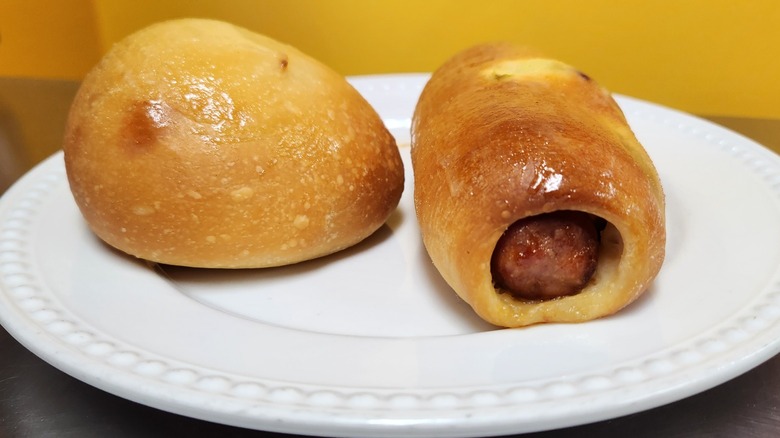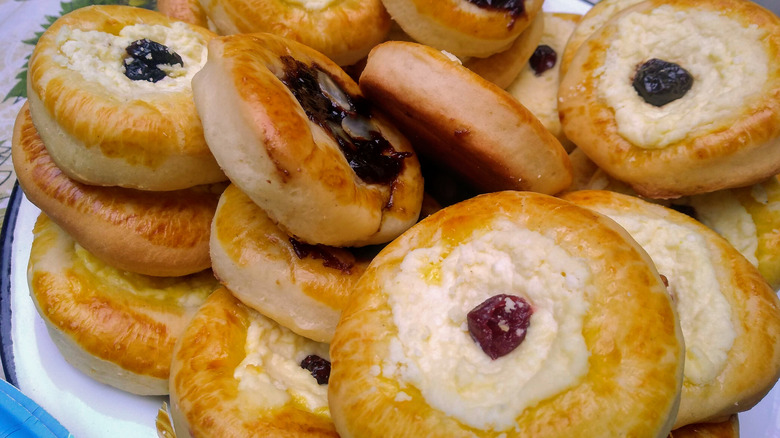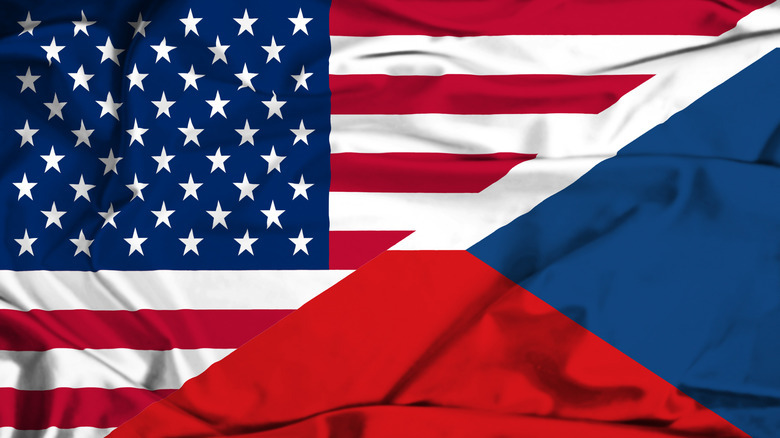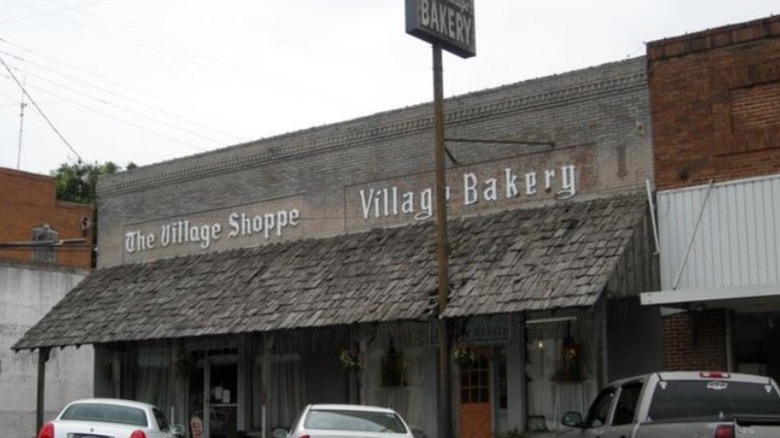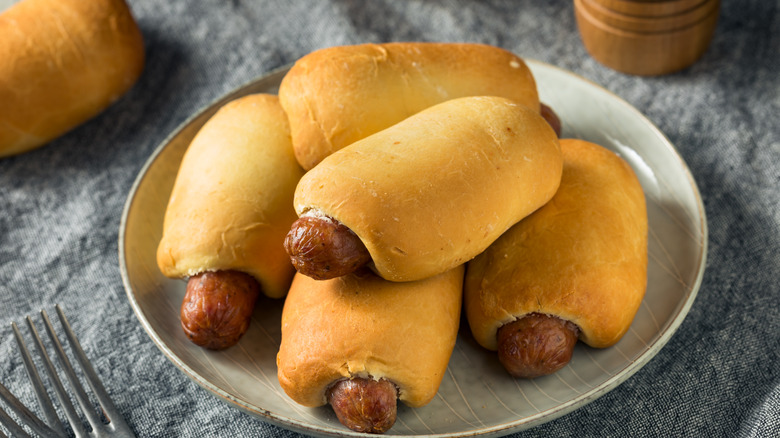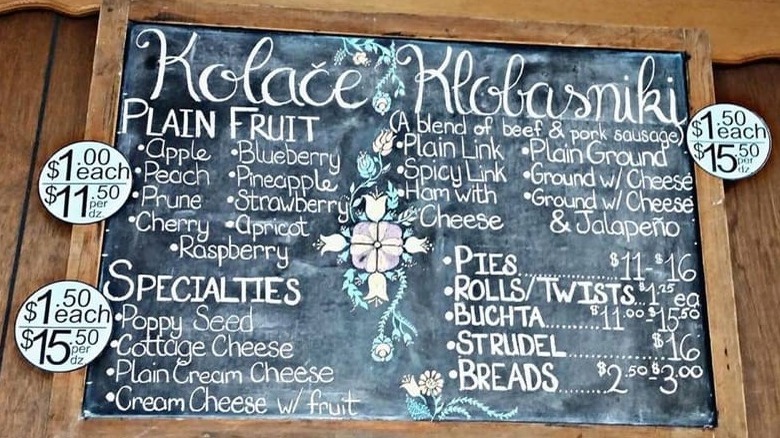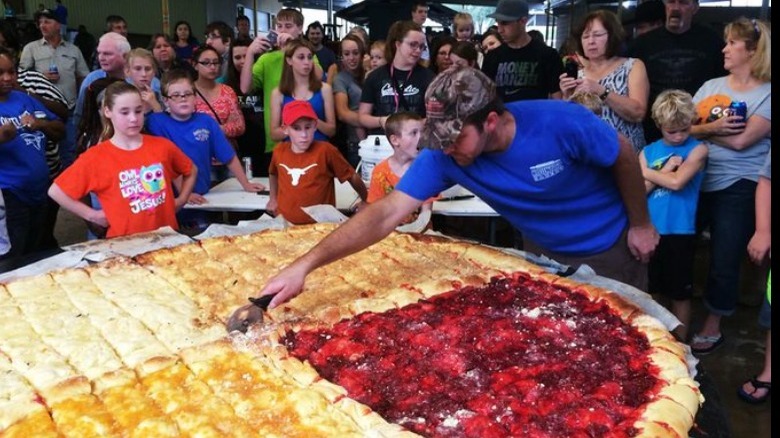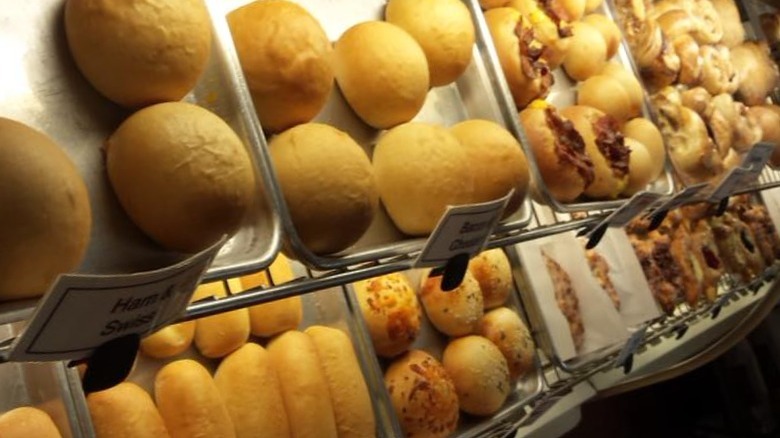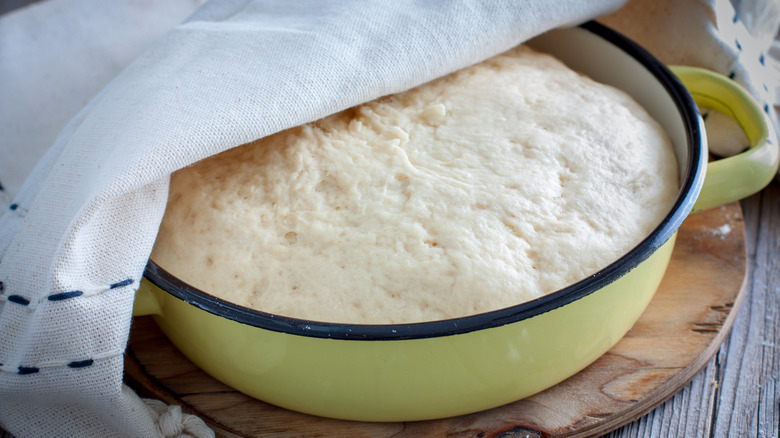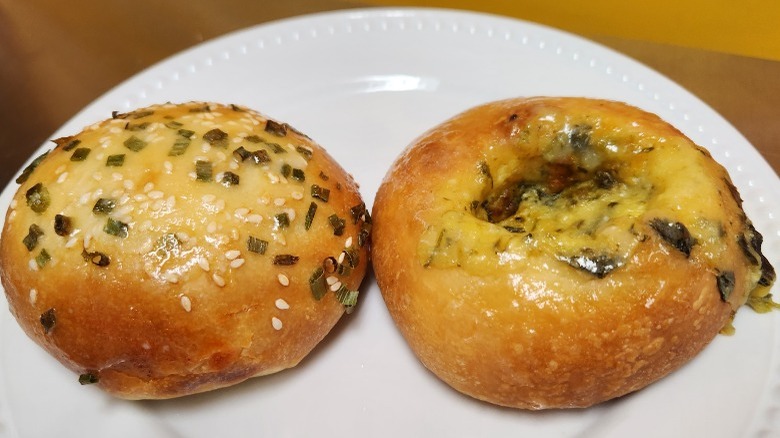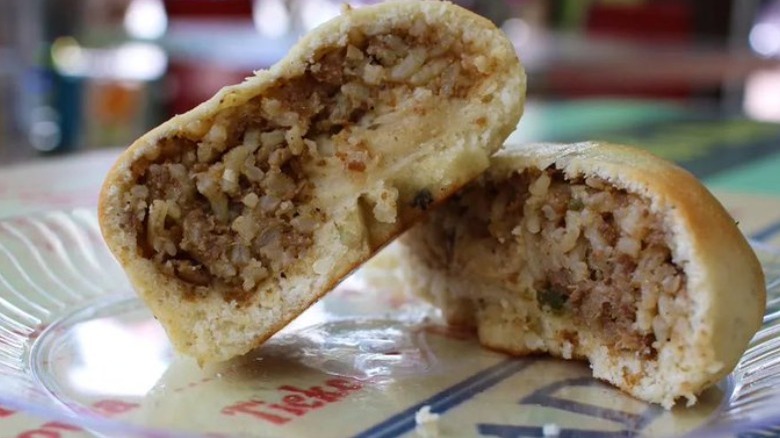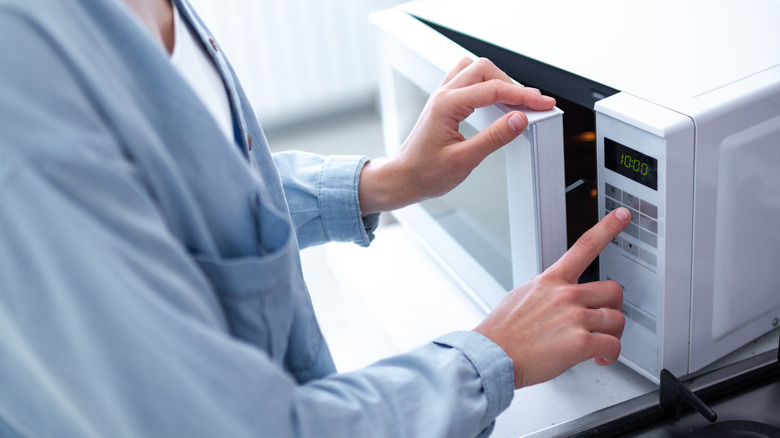Kolaches: 12 Things To Know About The Savory Treat
If you haven't had the pleasure of tasting a kolache, you're missing out on one of the U.S.'s very few hand-held savory pies. While the sweet kolache originated from the eastern part of the Czech Republic called Moravia, it was believed that a descendent from a Czech immigrant invented the savory kolache in Texas in the 1950s. What started out as a simple pigs-in-the-blanket-style sausage roll has evolved over the years to contain all sorts of breakfast foods and other tasty savory ingredients. Now, you can find them in gas stations, donut shops, and dedicated kolache shops. It's also migrated beyond Texas. When a kolache shop opened in Washington, D.C., hundreds of people familiar with them from their time in Texas lined up around the block (via NPR).
According to Texas Hill Country News, the word "kolache" comes from the Czech word "kola," which means "rounds" or "wheels." But what exactly are they? Imagine a circular savory roll filled with ham and cheese, barbecue brisket, or even sausage and gravy. It's both tasty and portable, and it works for any meal of the day. We've uncovered the history of the savory kolache in the U.S. and explained a bit of its evolution over time.
Savory kolaches are a fusion food
Savory kolaches have the distinction of being a fusion food since the kolaches you see in bakery cases in the U.S. are very different from the original kolaches created in what's now known as the Czech Republic. When the Czechs immigrated to the U.S. in the mid-1800s, they brought their family recipes. Kolaches started out as a traditional Czech food, but now they're also infused with Texan and American melting-pot cuisines.
Chef Edward Lee, author of "Buttermilk Graffiti: A Chef's Journey to Discover America's New Melting-Pot Cuisine" says there's no such thing as "authentic food" because traditions, culture, and food all evolve (via Slow Food USA). Foods like kolaches change with every new cook who makes them over time. As kolaches have spread throughout the U.S., they've picked up local flavors and other fusion additions. For example, American-melting-pot-style kolaches have been filled with everything from Cajun-style boudin sausage and Mexican-American hot dogs to Philly cheesesteak and chicken enchilada filling. Whatever your cultural or regional heritage, you can stuff something tasty from it inside a kolache.
The original kolache is sweet rather than savory
If you encounter a kolache in the Czech Republic, it will likely be sweet. The story goes that several generations back, a mother and daughter in the Moravia region of central Europe, which is now part of the Czech Republic, found a recipe for a sweet, yeasty roll filled with fruit or sweetened cheese. Once they made the recipe and shared it, the rest is history. Families all over Moravia began making kolaches. What was inside any given kolache depended on which fruits were available.
When kolaches began appearing in the U.S., they were a sweet confectionery. They contained the ingredients Czechs were accustomed to using at home, like prunes, apricots, and poppy seeds; however, they eventually began experimenting with other ingredients they found in the U.S., like blueberries, pineapples, and cream cheese (via NPR).
As kolaches have spread beyond Texas, the most popular ones have often been savory. When we talked to Isabella Milam, the co-owner of Golden Kolache Bakery in Fayetteville, Arkansas, about what sells better, she said that her bakers always make some sweet kolaches, but people tend to prefer the savory ones. People looking for something sweet are more likely to go to a donut shop or a traditional bakery instead. But kolaches can be a welcome savory option in those types of shops as well.
The kolache came to Texas with Czech immigrants
According to the University of Texas at San Antonio Institute of Texan Cultures, the first group of Czech immigrants started arriving in Texas around 1850 and continued coming for the next 60-plus years. The emigration from their homeland was spurred by cheap Texas farmland as well as difficulties back home when it came to politics and religion (via Texas State Historical Society). The Institute of Texan Cultures says that many of the Czech immigrants arriving in Texas tended to be from Moravia, which is in the eastern portion of what was to become Czechoslovakia in 1918.
According to the Institute of Texan Cultures, in total, about 250 Czech communities sprang up in Texas in Lavaca, Fayette, Brazos, Burleson, and Williamson counties in the southeastern part of the state, either between San Antonio and Houston, between Houston and Austin, or just north of Austin. Today, there are over 200,000 people of Czech descent living across the state.
It wasn't long before non-Czech Texans got their first bites of kolaches from their new neighbors. Texans started to be able to sample kolaches at Czech festivals and church bake sales. Eventually, Czech-owned bakeries started selling them (via NPR).
The savory kolache was born at the Village Bakery in West, Texas
While it was Czech immigrants who brought the kolache to Texas, it was also a Czech who is believed to have first started serving savory kolaches in Texas. The first Czech bakery in Texas to sell kolaches appears to be Village Bakery, which was open between 1952 and 2019 in the city of West, Texas. West is located along Interstate 35 between Austin and Dallas.
It was during the second year the bakery was open, in 1953, that co-owner Wendel Montgomery started to experiment (via Texas Monthly). One day, when he was eating a hot dog, he had the idea of using the kolache dough to make something new. He convinced his mother-in-law to wrap a sausage link in the dough and bake it. Thus, the savory kolache was born. To some, he's considered the "Grandfather of Kolaches" (via Texas Standard).
In some donut shops -– like Daylight Donuts in Oklahoma, Kansas, Missouri, and Arkansas -– dough filled with sausages are often the only type of kolaches available. You'll frequently see them labeled as "sausage rolls." Unfortunately, we've found that many donut shop sausage rolls don't contain sausages at all, just cheese hot dogs or cheese and jalapeño hot dogs. However, in other shops, you'll find savory kolaches with all sorts of fillings, not just sausage links (or hot dogs).
Some say savory kolaches should be called klobasniki
When the Village Bakery in West, Texas, first started making its savory kolaches, it gave these savory rolls a different name to distinguish them from sweet kolaches. The bakery used the same yeasty dough from the sweet kolaches. However, Wendel Montgomery wanted to differentiate them since they weren't the same (via Texas Monthly). Even though the savory kolaches were invented on American soil, Montgomery gave them a Czech name: "klobasniki" (via Facebook). Spellings vary, as you'll also see it as "klobasneky" or "klobasniky" by different people.
According to Montgomery's daughter, Mimi, who took on the bakery in later years, her father wasn't happy with people referring to klobasniki as "kolaches." "He never claimed it was the kolache. It infuriated him. That wasn't his mission. It was uniquely what it was, klobasniky -– 'little sausage,'" she told Texas Monthly.
Texas Monthly says that back in 2016, Austin American-Statesman journalist Katey Psencik begged Texans on behalf of the Czech community to stop calling the savory version "kolaches" and start calling them "klobasnek" (singular) or "klobasniky" (plural). Sadly, the term "klobasniky" has never really caught on and probably never will.
Most of us are spelling and saying it wrong
When food crosses cultural and language barriers, people tend to make spelling and pronunciation changes because of different alphabets, different grammar rules, or unfamiliar letter sounds. For example, most Mexican food lovers haven't realized that the singular version of "tamales" in Spanish is "tamal" rather than "tamale." And most Italian confection lovers don't realize that "cannoli" is the plural version of "cannolo." With an unfamiliar language like Czech, it's no wonder we've also made a few mistakes.
The actual Czech spelling for "kolache" is "koláče" (via Czechology). However, since the English language has no "č" or "á", someone eventually Americanized the spelling to get the pronunciation a little closer to correct.
Also, when you're saying "kolache," you're actually using the plural version of the word. "Kolach" is singular, while "kolache" is plural (via KBTX). So, every time we say "kolaches," we're pluralizing an already-plural word. Technically, we're doing the equivalent of saying "rollses" instead of "rolls." Classy.
Most of us also pronounce it incorrectly. Even The New York Times tells us to say it "ko-LAH-chee," but that isn't quite right. @TeAge from the Czech Republic demonstrates that the correct pronunciation for "koláče" is closer to "KO-LAAAAH-chay," drawing out the middle syllable far longer than the others (via Forvo Pronunciation). Also from the Czech Republic, @kunk reveals that the correct pronunciation for a singular koláč is "ko-LACH" (via Forvo Pronunciation). Now you know.
Texas has kolache festivals
Many of the very first tastes that non-Czech Texans had of kolaches were at Czech festivals. Even though Czechs have been in Texas for multiple generations now, they still like to celebrate their heritage with festivals, including kolache festivals. Caldwell, Texas, calls itself the "kolache capital of Texas," and its festival is the biggest yearly event in Burleson County (via Festivalnet). Burleson County is one of the original counties between Austin and Houston where Czechs immigrated (via Institute of Texan Cultures).
Of course, you can expect plenty of kolaches at Caldwell's kolache festival, but the 40 or so food booths may make it difficult to choose where to eat (via Festivalnet). The festival's Facebook page reveals that you can expect traditional Czech polka, kids' activities and rides, and the Kolache Krunch 5K run. You can attend shows for quilts, antique machinery, tractors, street rods, and classic cars. Also on site is the Burleson County Czech Heritage Museum.
Hallettsville, Texas, in Lavaca County (another of the original counties where Czechs settled) also has a kolache festival that has been running since 1995. It features a 5K run or walk, a domino tournament, a parade, a kolache baking demo, live music, a car show, and a Texas-style barbecue cook-off. Oh, and it also has a kolache-eating contest for the brave and hungry (via Halletsville Chamber of Commerce).
Kolaches are among the few savory hand-held pies in the U.S.
When Wendel Montgomery invented the klobasnek (savory kolache) in West, Texas, in 1953, he was inadvertently creating one of the U.S.'s very few savory hand-held pies (per Texas Monthly). When you think about it, the U.S. doesn't have a lot of them. Yet, they're infinitely useful, easily transportable, and self-contained meals.
Australia has meat pie, Lebanon has sfiha, Morocco has pastilla, Malaysia has karipap, China has xian bing, Russia has piroshki, and Latin America has empanadas (via Tasting Table). The list goes on and on. Yet, if you stop and try to think of what the U.S. has that we didn't borrow from another country, most of us couldn't think of anything except frozen Hot Pockets or chicken pot pies.
Besides savory kolaches, one of the few other hand-held savory pies we know of from the U.S. is the Michigan pasty, which came to that state's Upper Peninsula via a group of people from Cornwall, England, mining copper in the 1800s (via NPR). Another savory pie that is enclosed like an empanada is in Natchitoches, Louisiana, which is known as "The Meat Pie Capital of Louisiana" and has its own festival (via KTBS). There are probably other local handheld meat pies in various communities. However, in most parts of the U.S., you're not going to be able to locate a portable meat pie as easily as you can in countries like Australia without branching out into non-American cuisine.
One of the appeals of the kolache is its yeasty outer layer
We visited the Golden Kolache Bakery in Fayetteville, Arkansas, and observed part of the process of creating kolaches. Baking a kolache actually starts the day before they are sold. One of the first steps involves placing the yeasty, savory dough into an oversized metal bowl, covering it, and placing it in a warm spot so that it can ferment and rise. At the Golden Kolache Bakery, that place is in a warm, sunny window.
According to food scientist Harold McGee, yeast releases carbon dioxide during the fermentation process. However, since the gases are enclosed in the dough, they get trapped, which is what happens when you see dough rise. By the end of the fermentation process, the dough just about doubles in size (via "On Food and Cooking").
Isabella Milam, co-owner of Golden Kolache Bakery, showed us how, after the dough has risen, the bakers divide it into small balls to await filling and baking by employees starting at 3:30 a.m. Once they bake the filled kolaches, the Maillard reaction does its job of making the outside golden and delicious.
Milam says that how many kolaches the bakery sells depends on the month or the day of the week, with Friday and Saturday being extremely popular times. However, even on a slow weekday in January, Milam says she bakes over 200 kolaches.
Savory kolaches have evolved as they've spread in popularity
The Village Bakery, the birthplace of the savory kolache, branched out slightly from its original link-sausage creation. Eventually, it sold kolaches with ham and cheese and with ground sausage, cheese and jalapeños (via Facebook).
Most people think of savory kolaches as breakfast food. So, as they have evolved, many shops have filled them with breakfast ingredients like meat, eggs, and cheese. In addition to breakfast kolaches, the Golden Kolache Bakery in Fayetteville, Arkansas, has other options, like spinach and artichoke ones or Mediterranean ones containing feta cheese, artichokes, kalamata olives, and capers. We've even seen some shops that bake them in muffin tins for a kolache that looks more like a giant popover.
If you think only locations outside of Texas are getting creative with kolaches, you'd be wrong. The Kolache Factory, which started out in Houston, Texas, sold one containing brisket, jalapeños, and macaroni and cheese (via Texas Monthly). And John T. Edge of The New York Times reports seeing kolaches stuffed with boudin (a Cajun sausage with rice and spices) in Houston and ones with sausage and sauerkraut in Austin.
When Texas Monthly asked about what the inventor of the klobasniky would think about its evolution, his daughter, Mimi Montgomery Irwin, said, "My father would probably have been aghast at the idea." She calls all the changes throughout the U.S. "the McDonaldization of a Czech food." Luckily, the majority are far superior to fast food.
Boudin kolaches have become popular
One of the fillings we've seen popping up in kolaches lately is boudin (pronounced "BOO-dan"). If you're not familiar with this iconic Cajun food, it's a sausage made with spicy pork, rice, onions, and peppers. While you can find a type of boudin in France, it's very different than the Cajun version from Louisiana (via Cajun Tour Foods).
A boudin kolache is the poster child for fusion food since it combines Czech, Texan, French, and Cajun cuisine all at once. With Texas being right over the border from Louisiana, it was inevitable that boudin would get itself mixed up with kolaches. A quick look for boudin kolaches on Yelp uncovers them in the Texas cities of Dallas, Austin, and Houston. Meanwhile, you'll also find them in the Louisiana cities of Lafayette, Baton Rouge, and New Orleans.
But boudin kolaches aren't just in Texas and Louisiana. They're migrating to other cities in other states, like Oklahoma City, Oklahoma. Since we'd seen boudin kolaches nearby, we asked the co-owner of Golden Kolache Bakery in Fayetteville, Arkansas, if her bakery had them yet. She said she would like to add boudin kolaches to the menu since so many people have been asking about them. Once you try them, they seem like the obvious ingredient for a savory kolache.
There are several ways to warm up cold or leftover kolaches
When a baker procures a savory kolache for you, they'll often ask if you plan to eat it now or later. If now, they'll sometimes throw it in the microwave for a few seconds to warm the ingredients inside. If you're taking them home for later, the baker can give you heating instructions.
The amount of time in the microwave depends on the size and the number of kolaches you are heating at one time. According to Kolache Factory, you should microwave one or two for 10-15 seconds. However, the Golden Kolache Bakery quoted us 20 seconds, which seemed perfect. According to Kolache Factory's instructions, you should add an additional five to 10 seconds for every two additional kolaches you microwave. The trick is to heat them long enough to get the filling hot but not too long that the outside bread portion becomes chewy or (in a worst-case scenario) like a hockey puck.
The Kolache Factory also says you can heat them in your oven for five minutes at 325 degrees Fahrenheit. Using the oven instead of the microwave is especially helpful if you're reheating kolaches for a crowd.
